 By Rodney Dickens The February Raving provided three reasons why economic growth would recover earlier than was generally expected. The three reasons were: a housing recovery, which is now underway; some healing of the financial crisis, which is also underway; and a turnaround in the stock cycle, which is the focus of this Raving. This Raving uses the international car market to explain the important role the "stock cycle" is starting to play in underwriting an earlier recovery in global growth than was generally expected. The stock cycle will also play an important part in the NZ economic recovery. The big table below shows that in June 2009 all but one category of US vehicle sales were down dramatically on June 2008. The only category not to experience a double digit fall was small SUVs where sales were up 1.3% but this will be driven by a switch away from gas-guzzling large and mid-sized SUVs where the number of sales was down 51% and 44% respectively. But in the year to June 2009 sales of small SUVs were down 15.6%. The number of imported car sales in June 2009 was down 34.3% versus a marginally smaller 30.6% fall in sales of domestically produced cars. So it is no wonder that higher cost producers have their backs to the wall.
By Rodney Dickens The February Raving provided three reasons why economic growth would recover earlier than was generally expected. The three reasons were: a housing recovery, which is now underway; some healing of the financial crisis, which is also underway; and a turnaround in the stock cycle, which is the focus of this Raving. This Raving uses the international car market to explain the important role the "stock cycle" is starting to play in underwriting an earlier recovery in global growth than was generally expected. The stock cycle will also play an important part in the NZ economic recovery. The big table below shows that in June 2009 all but one category of US vehicle sales were down dramatically on June 2008. The only category not to experience a double digit fall was small SUVs where sales were up 1.3% but this will be driven by a switch away from gas-guzzling large and mid-sized SUVs where the number of sales was down 51% and 44% respectively. But in the year to June 2009 sales of small SUVs were down 15.6%. The number of imported car sales in June 2009 was down 34.3% versus a marginally smaller 30.6% fall in sales of domestically produced cars. So it is no wonder that higher cost producers have their backs to the wall.
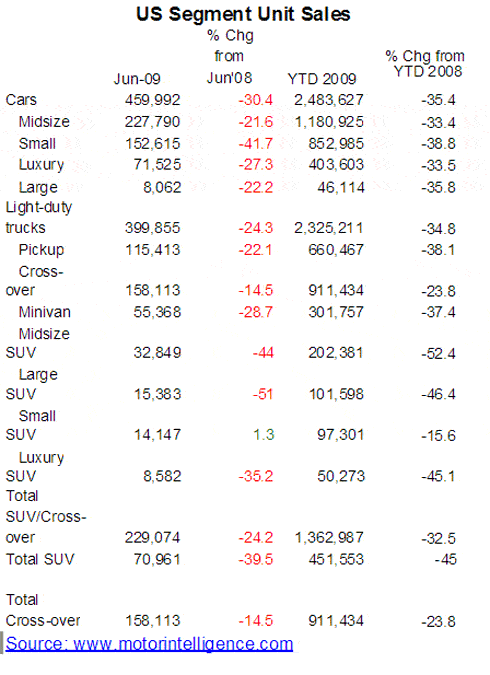 The BBC just released an article proclaiming that "Woes continue for world carmakers." Based on the continued stream of negative media headlines, most people will be surprised to learn that US car sales have rebounded 10% since the trough in January on a seasonally adjusted basis (a 6% rise when light trucks are included). The left chart below shows monthly car sales and light truck sales (i.e. pickups, "cross-overs" and SUVs). The fall in petrol prices shown in the right chart will have played a part in the recovery in vehicle sales as will have cuts in car/light truck prices.
The BBC just released an article proclaiming that "Woes continue for world carmakers." Based on the continued stream of negative media headlines, most people will be surprised to learn that US car sales have rebounded 10% since the trough in January on a seasonally adjusted basis (a 6% rise when light trucks are included). The left chart below shows monthly car sales and light truck sales (i.e. pickups, "cross-overs" and SUVs). The fall in petrol prices shown in the right chart will have played a part in the recovery in vehicle sales as will have cuts in car/light truck prices. 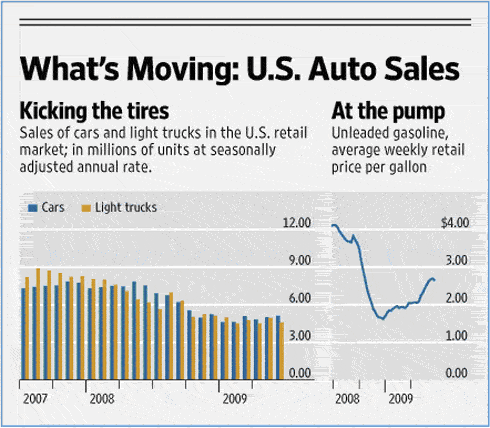 The US$1b "cash for clunkers" deal appears to be underwriting a stronger rebound in sales in July as covered in this story. By the time the US$1b subsidy to new car buyers runs out, which some pick will happen as early as 1 August given the rush of demand it has inspired, car sales will be up much more than the 10% increase recorded in the first half of the year. This is partly because car dealers are also coming up with their own initiatives. But the turnaround in the stock cycle will mean that car manufacturers will experience a much larger rebound in sales than car retailers. When I started studying economics 35 years ago we were taught about the major role the stock cycle plays in economic cycles. But it seems many younger economists either never got taught this or simply don't appreciate its importance. The international car industry will provide a wonderful example of the important role the stock cycle plays at the industry-level, but with many industries in the same boat the turnaround in the stock cycle is starting to have a major positive impact on global growth. Even after US car sales had started to recover, emails were flying around the world with photos attached showing the stockpiles of unsold cars around the world, especially new cars. In the UK The Sun reported on 21 March that "Cars worth £1bn are stockpiled". The Guardian's website still has 13 photos with the introduction to the photos reading: "Carmakers around the world are cutting production as inventories build up to unprecedented levels. Storage areas and docksides are now packed with vast expanses of unsold cars as demand slumps." If a picture is worth 1,000 words the 13 pictures are like a 1,000 page novel dedicated to getting across the message that car producers are well and truly stuffed. Once subjected to these photos most people will be forgiven for concluding that the road to recovery for car manufacturers will be a long way off. The conventional wisdom appears to be that it will be a slow recovery for new car sales and an even slower recovery for new car production because of the stockpile, but this view doesn't take account of the role of the stock cycle actually plays in economic cycles. In the first stage of the economic downturn, car manufacturers were understandably slow to realise the magnitude of the fall in new car sales so the stockpiles in the photos occurred because production ran ahead of the new, much lower level of demand for new cars by consumers. In stage two of the adjustment, manufacturers, who in many cases in the car market are also car retailers, cut new car prices and slashed production to try and clear the stockpile. This article in the Telegraph dated 17 February reported 20-50% cuts in new car prices and moves by manufacturers to cut production. We are probably now well into the third stage of the process in which production numbers are cut below new car sales numbers while efforts to stimulate demand are also at work (i.e. cuts in new car prices and government initiatives of the likes adopted in Germany, the UK and the US to encourage increased demand for new cars). Cutting production below consumption levels is what allows the stockpile of new cars to be depleted, which should already be starting to happen. In time, the surplus stockpile of cars will be depleted and this is when we enter the fourth stage of the stock cycle, which is the exciting stage we should soon be entering. In this stage the manufacturing sector will experience a much larger rebound in demand than has been experienced by car retailers. At the moment, a significant amount of demand for new cars is being met by selling cars from the stockpile, which means demand for new car production has fallen well below the level of consumer demand for new cars, even allowing for the fall in new car sales. This is why manufacturers get toasted even more than car retailers during the earlier stages of the stock cycle. However, once car dealers and manufacturers have got stocks back to the desired levels the full amount of consumer demand will start filtering through to car manufacturers again. This is what lies ahead for international car manufacturers. The beauty of the stock cycle is that manufacturers can get a major boost in demand even without a significant increase in final sales, which is just the flipside of the pasting they experienced while the stockpile was being used to meet a significant amount of final demand for new cars. And when consumer demand/retail sales recovers sufficiently there will be a final stage of the stock cycle during which stock levels will be rebuilt and help new car production run above final sales for a bit longer. Internationally we are seeing the benefit of a turnaround in the stock cycle in enough industries that it is playing an important part in delivering an earlier than expected recovery in global economic growth (i.e. early compared to what most economists predicted but roughly in time with what we have been suggesting would happen in our monthly pay-to-view Interesting Times reports). The turnaround in the stock cycle will have played a significant part in the rebound in new orders (domestic and export) and export orders in US manufacturing and non-manufacturing sectors this year (top two charts below). The charts below show that V-shaped recoveries in especially manufacturing-orientated leading indicators in a range of countries including Japan (where industrial production has rebounded 16.5% between February and June after falling 37% between February 2008 and February 2009), Euroland, China, Canada and most notably Australia. Of course part of the story is the stock cycle and part is the benefit of interest rate cuts, tax cuts and other fiscal stimuli. The countries with the prospect for early and strong economic recoveries are those that will also experience a strong upturn in housing market activity, which includes Australia and NZ.
The US$1b "cash for clunkers" deal appears to be underwriting a stronger rebound in sales in July as covered in this story. By the time the US$1b subsidy to new car buyers runs out, which some pick will happen as early as 1 August given the rush of demand it has inspired, car sales will be up much more than the 10% increase recorded in the first half of the year. This is partly because car dealers are also coming up with their own initiatives. But the turnaround in the stock cycle will mean that car manufacturers will experience a much larger rebound in sales than car retailers. When I started studying economics 35 years ago we were taught about the major role the stock cycle plays in economic cycles. But it seems many younger economists either never got taught this or simply don't appreciate its importance. The international car industry will provide a wonderful example of the important role the stock cycle plays at the industry-level, but with many industries in the same boat the turnaround in the stock cycle is starting to have a major positive impact on global growth. Even after US car sales had started to recover, emails were flying around the world with photos attached showing the stockpiles of unsold cars around the world, especially new cars. In the UK The Sun reported on 21 March that "Cars worth £1bn are stockpiled". The Guardian's website still has 13 photos with the introduction to the photos reading: "Carmakers around the world are cutting production as inventories build up to unprecedented levels. Storage areas and docksides are now packed with vast expanses of unsold cars as demand slumps." If a picture is worth 1,000 words the 13 pictures are like a 1,000 page novel dedicated to getting across the message that car producers are well and truly stuffed. Once subjected to these photos most people will be forgiven for concluding that the road to recovery for car manufacturers will be a long way off. The conventional wisdom appears to be that it will be a slow recovery for new car sales and an even slower recovery for new car production because of the stockpile, but this view doesn't take account of the role of the stock cycle actually plays in economic cycles. In the first stage of the economic downturn, car manufacturers were understandably slow to realise the magnitude of the fall in new car sales so the stockpiles in the photos occurred because production ran ahead of the new, much lower level of demand for new cars by consumers. In stage two of the adjustment, manufacturers, who in many cases in the car market are also car retailers, cut new car prices and slashed production to try and clear the stockpile. This article in the Telegraph dated 17 February reported 20-50% cuts in new car prices and moves by manufacturers to cut production. We are probably now well into the third stage of the process in which production numbers are cut below new car sales numbers while efforts to stimulate demand are also at work (i.e. cuts in new car prices and government initiatives of the likes adopted in Germany, the UK and the US to encourage increased demand for new cars). Cutting production below consumption levels is what allows the stockpile of new cars to be depleted, which should already be starting to happen. In time, the surplus stockpile of cars will be depleted and this is when we enter the fourth stage of the stock cycle, which is the exciting stage we should soon be entering. In this stage the manufacturing sector will experience a much larger rebound in demand than has been experienced by car retailers. At the moment, a significant amount of demand for new cars is being met by selling cars from the stockpile, which means demand for new car production has fallen well below the level of consumer demand for new cars, even allowing for the fall in new car sales. This is why manufacturers get toasted even more than car retailers during the earlier stages of the stock cycle. However, once car dealers and manufacturers have got stocks back to the desired levels the full amount of consumer demand will start filtering through to car manufacturers again. This is what lies ahead for international car manufacturers. The beauty of the stock cycle is that manufacturers can get a major boost in demand even without a significant increase in final sales, which is just the flipside of the pasting they experienced while the stockpile was being used to meet a significant amount of final demand for new cars. And when consumer demand/retail sales recovers sufficiently there will be a final stage of the stock cycle during which stock levels will be rebuilt and help new car production run above final sales for a bit longer. Internationally we are seeing the benefit of a turnaround in the stock cycle in enough industries that it is playing an important part in delivering an earlier than expected recovery in global economic growth (i.e. early compared to what most economists predicted but roughly in time with what we have been suggesting would happen in our monthly pay-to-view Interesting Times reports). The turnaround in the stock cycle will have played a significant part in the rebound in new orders (domestic and export) and export orders in US manufacturing and non-manufacturing sectors this year (top two charts below). The charts below show that V-shaped recoveries in especially manufacturing-orientated leading indicators in a range of countries including Japan (where industrial production has rebounded 16.5% between February and June after falling 37% between February 2008 and February 2009), Euroland, China, Canada and most notably Australia. Of course part of the story is the stock cycle and part is the benefit of interest rate cuts, tax cuts and other fiscal stimuli. The countries with the prospect for early and strong economic recoveries are those that will also experience a strong upturn in housing market activity, which includes Australia and NZ. 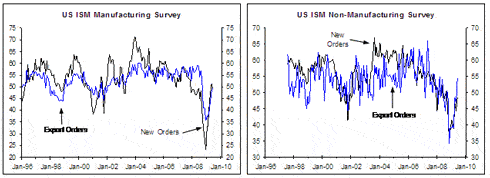
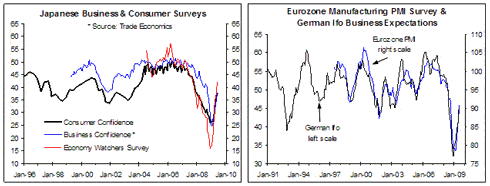
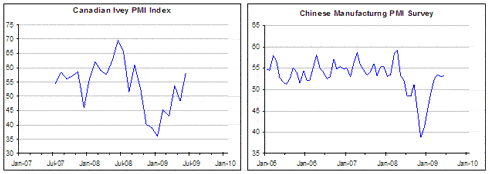
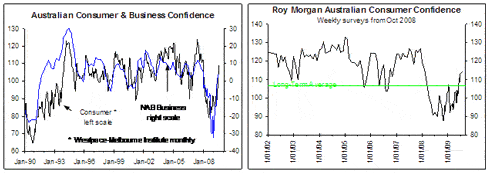 Even in the US there is a hint of recovery emerging in housing market activity indicators (the two charts below) and it will be a surprise to many that one of the monthly measures of the US median house price has increased 10% since January following a 28% fall from the peak level in July 2006. Without a strong recovery in the housing market the US will underperform the likes of Australia and NZ but just as the stock cycle will start to deliver a major positive surprise for international car manufacturers this year the US house building market will be the beneficiary of its own stock cycle. While demand for new houses has fallen dramatically in the US, new house building has been hit even harder because some of the demand for new houses is being meet from the surplus spec houses that were built during the boom. But with the US population continuing to grow at around 2.5 million per annum, the stockpile of new houses is being consumed (and in some cases destroyed as was shown in a u-tube video that circulated a couple of months ago) and so the new house building market will experience an earlier boost than generally expected just as will be the case with car manufacturing thanks to the stock cycle. There is already a hint of this in the NAHB/Wells Fargo survey of residential builders (blue line, right chart below).
Even in the US there is a hint of recovery emerging in housing market activity indicators (the two charts below) and it will be a surprise to many that one of the monthly measures of the US median house price has increased 10% since January following a 28% fall from the peak level in July 2006. Without a strong recovery in the housing market the US will underperform the likes of Australia and NZ but just as the stock cycle will start to deliver a major positive surprise for international car manufacturers this year the US house building market will be the beneficiary of its own stock cycle. While demand for new houses has fallen dramatically in the US, new house building has been hit even harder because some of the demand for new houses is being meet from the surplus spec houses that were built during the boom. But with the US population continuing to grow at around 2.5 million per annum, the stockpile of new houses is being consumed (and in some cases destroyed as was shown in a u-tube video that circulated a couple of months ago) and so the new house building market will experience an earlier boost than generally expected just as will be the case with car manufacturing thanks to the stock cycle. There is already a hint of this in the NAHB/Wells Fargo survey of residential builders (blue line, right chart below). 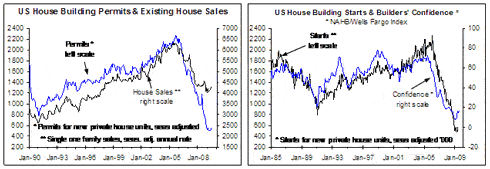 _________________ * Rodney Dickens is the Managing Director and Chief Research Officer for Strategic Risk Analysis (SRA), which is a boutique economic, industry and property research company. Rodney produces regular free reports on topical issues and on specific property markets. Find out more about SRA here and sign up to SRA's free reports here.
_________________ * Rodney Dickens is the Managing Director and Chief Research Officer for Strategic Risk Analysis (SRA), which is a boutique economic, industry and property research company. Rodney produces regular free reports on topical issues and on specific property markets. Find out more about SRA here and sign up to SRA's free reports here.

We welcome your comments below. If you are not already registered, please register to comment
Remember we welcome robust, respectful and insightful debate. We don't welcome abusive or defamatory comments and will de-register those repeatedly making such comments. Our current comment policy is here.